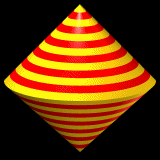Sphericon
It was discovered independently by carpenter Colin Roberts (who named it) in the UK in 1969,[1] by dancer and sculptor Alan Boeding of MOMIX in 1979,[2] and by inventor David Hirsch, who patented it in Israel in 1980.
Around 1969, Colin Roberts (a carpenter from the UK) made a sphericon out of wood while attempting to carve a Möbius strip without a hole.
While examining various configurations of this device, he discovered that the form created by joining the two half discs, exactly at their diameter centers, is actually a skeletal structure of a solid made of two half bicones, joined at their square cross-sections with an offset angle of 90 degrees, and that the two objects have exactly the same meander motion.
In response, Stewart wrote an article "Cone with a Twist" in his Mathematical Recreations column of Scientific American.
[2][8] The company's later piece "Dream Catcher" is based around a similar Boeding sculpture whose linked teardrop shapes incorporate the skeleton and rolling motion of the oloid, a similar rolling shape formed from two perpendicular circles each passing through the center of the other.




